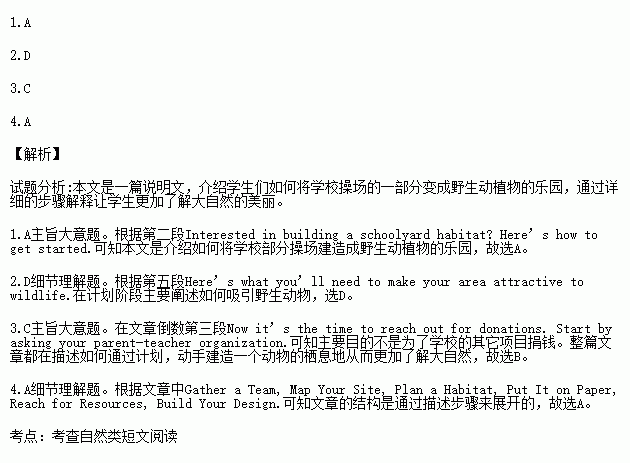题目内容
Bluebirds looking secretly from nest boxes. Tadpoles swimming in a pond. Tiger swallowtails flying quickly around a butterfly bush. And over here, a class of students watching it all. A field trip to a nature center? No, it’s a schoolyard. With some work on your part, it could even be your schoolyard.
Interested in building a schoolyard habitat? Here’s how to get started.
Gather a Team
Students can do a lot on their own, but you’ll need adults for a project this big. Get teachers, parents, and even the headmaster interested. Don’t forget the maintenance(维修)staff—they know more about your school’s yard than anyone else and can give you lots of help. Also, ask around your neighborhood for gardeners, naturalists, and others willing to give advice.
Map Your Site
Which part of the schoolyard can you turn into a habitat? Is there an unused corner of the playground? Part of a lawn or field you could let go wild? You’ll need to make a map of the area showing what’s there now. Then you can figure out how you want to change it. For that, you need a plan.
Plan a Habitat
Here’s what you’ll need to make your area attractive to wildlife.
Food: Plant flowers, bushes, and trees. These provide seeds, berries, leaves, flowers, and sweet liquids. And all of these feed birds, and insects. You can also add some feeders for squirrels and birds. Where possible, stick with native plants—wild plants that grow naturally in your area. They need less care, which means less work for you.
Water: A small pond, birdbath, or even a shallow dish of clean water in the ground will attract birds. Other small animals like insects may visit as well.
Shelter: Bushes and trees make great escapes for birds. Tall grass and “weeds” are home to grasshoppers, garter snakes, and some ground-nesting birds. You can also add stone piles and brush piles.
Places to Raise Young: Butterflies need special plants to lay their eggs on. Frogs and toads lay eggs only in shallow water. Many birds use birdhouses; others nest in trees and bushes. In fact, nearly all your shelters may become homes for wild young.
Put It on Paper
Using the map you made of your area, draw in the changes you want to make. Mark where the plants, nest boxes, and other items will go. Remember, this is a long-term plan—you don’t have to do everything this spring. Maybe you could put up a few birdhouses and plant some butterfly bushes now and save the trees and bushes for next year. Even a small start is a big step for wildlife.
Reach for Resources
To make the habitat happen, you’ll need lots of plants, seeds, and other supplies. You’ll also need to buy or borrow tools and maybe even some heavy equipment. Now’s the time to reach out for donations. Start by asking your parent-teacher organization. Then go to garden clubs, garden stores (they might give you a discount), local government agencies, and businesses. If they can’t donate supplies or money, ask if they can donate workers!
The workers can help build the habitat. You’ll also need people to help maintain it. Some schools ask their students’ families to take turns during the summer. Each family maintains the habitat for a couple of weeks.
Build Your Design
Now you can dig in. Set a date, and get growing!
1.What is this article mostly about?
A. How to start a wildlife habitat.
B. Making a place where animals can hide.
C. How to gather food for a wildlife habitat.
D. Creating places for people to plant gardens.
2.The section “Plan a Habitat” is mostly about___________.
A. finding a place to use for the habitat
B. how to raise money for the habitat
C. finding people to work on the habitat
D. how to attract wildlife to the habitat
3.The main purpose for creating a nature habitat at school would be to___________.
A. improve the school’s appearance
B. raise money for other school projects
C. teach students more about nature
D. convince people to work as volunteers
4.How has the author organized the article?
A. By giving step-by-step instructions.
B. By listing both sides of an argument.
C. By telling a story, from beginning to end.
D. By listing facts, from most to least important.
 新课标阶梯阅读训练系列答案
新课标阶梯阅读训练系列答案
